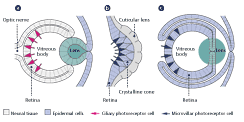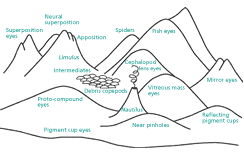
Have the structural similarities among eyes resulted from evolutionary convergence due to similar selective pressures (analogous) or from descent from a common ancestor (homologous)? This distinction is particularly hard to draw when comparing eyes because the physical laws governing light greatly restrict the construction of eyes. Similar eye structures may have arisen in unrelated animals simply because of constraints imposed by light.
The most commonly cited example of evolutionary convergence are the eyes of squids and fish. Both of these are 'camera-type' eyes, in which an image is formed on the photosensitive retinal layer at the back. Moreover, both have evolved a spherical lens with an exquisitely constructed gradient of refractive index that allows good focus despite their spherical shape. In addition, both types of eyes use the same light-sensitive molecule, opsin, to convert photons into neural energy. However, the fish retina is inverted, meaning the light-sensing cells are at the very back of the eye (inverse) while those in squid are at the front of the retina (everse). Moreover, the parts of the eyes of fish and squid arise from very different embryological sources during development, suggesting different origins for these eye types.
Paired eyes in the three major phyla, vertebrates, arthropods and mollusks (fig. 4), have long been considered to be classic examples of evolutionary convergence. At the macroscopic level, this must be true since they arise from different tissues and have evolved radically different solutions to the common problem of collecting and focusing light. However, as discussed above, opsin has a significant DNA sequence homology across all phyla. Remarkably, recent work by Gehring and Ikeo [9] has shown that features of ocular development in different phyla can be coordinated by a homologous 'master' gene, Pax-6. That a single gene could trigger construction of an animal's eye in diverse species led to their proposal that eyes are monophyletic, i.e. evolved only once. This is an interesting hypothesis that goes against all the previous suggestions of multiple (i.e. polyphyletic) origins for eyes. There are several reasons why this hypothesis seems difficult to support. It is well known that Pax-6 organizes other structures besides eyes and is even necessary for the onset of various actions outside the nervous system. Also, other genes can cause development of eyes [reviewed in 10]. Whether eyes are monophyletic or not, the work of Gehring and his colleagues has stimulated a great deal of new work on eye evolution, which is a good thing in itself.
Clearly, eyes have common molecular constituents whether they be opsins, Pax-6, or others. Yet, homology at the molecular level of organization does not predict homology at the organ or organismic level. Molecules are not eyes.
Conclusions
Eyes exist in a variety of shapes, sizes, optical designs and locations on the body, but they all provide similar information about wavelength and intensity of light to their owners. Different tissues have been recruited to build lenses and retinas across the phyla. In contrast, all eyes share the same mechanism of absorbing photons, i.e. the opsin-chromophore combination has been conserved across phylogeny. Despite new findings yielded by powerful molecular techniques, all evidence still suggests that eyes have a polyphyletic origin, with the caveat that they contain homologous molecules responsible for many structural, functional and even developmental features (fig. 5). Given a growing list of homologous gene sequences amongst molecules in the eye across vast phylogenetic distances, the challenge is now to discover what makes the eyes of Drosophila, squid and mouse so different. Since strictly homologous developmental processes must produce homologous structures, key elements responsible for the development of nonhomologous eyes remain missing. Understanding what makes eyes different may be a bigger challenge than finding what they have in common.
The Evolution of Eyes
Why Do We See What We See?
How Do Eyes Work and How Did They Evolve?
How Do Eyes Capture Photons?
Where Do Lenses Come From?
Eyes: Convergence or Homology?
Conclusions
References
Biography
>> next

